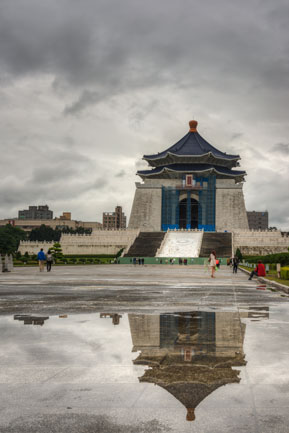Chiang Kai-Shek Memorial Hall in Taipei

Chiang was born in 1887 in Xikou, a small town in Zhejiang province on the Chinese mainland. His family was prosperous and traditional, so Chiang received a Confucian education before committing himself to a military career and the modernisation of China. Like Sun Yat-sen, whom he revered, he was overseas when China’s imperial system of government collapsed. He spent the 1920s consolidating his power, the 1930s fighting China’s growing communist movement, and the 1940s leading the Nationalists first against Japan and then against Mao Zedong. Huge amounts of US aid helped him overcome the first enemy but not the second. He and his followers withdrew to Taiwan in 1949; they set up a government-in-exile which until the early 1970s enjoyed the support and recognition of many Western countries.
Plans for the memorial were drawn up soon after the generalissimo’s death on April 5, 1975, and the structure was inaugurated exactly five years later. The blue-roofed, white-sided main building is unlike any other buildings in Taipei. The National Concert Hall and National Theatre, which stand at the other end of the plaza, are more in keeping with the Northern-Palace style of architecture adored by Chiang and exemplified by Taipei’s Grand Hotel.
The main hall holds a larger-than-life bronze of Chiang which is protected around the clock by military police. The dictator is seated and dressed as if off duty, but wears a rather stern expression. The goose-stepping precision of the ritual changing of guard (each hour on the hour) is absolutely engrossing.
Downstairs there are displays about the late president’s life and achievements. While very little effort is made to present a balanced picture, those with an interest in Greater China’s 20th-century history will want to see the photographs of Chiang during the Northern Expedition which unified China in the late 1920s, and directing the defence of Kinmen (Quemoy) in the early 1950s.
In recent years, the memorial’s grounds have been used for various cultural events completely unrelated to Chiang or his historical era, among them a 2015 SpongeBob SquarePants exhibition and a 2023 Doraemon show!
Getting to the memorial is simple. Taipei Metro’s Red Line and Green Line converge at Chiang Kai-shek Memorial Hall Station. Walking from Taipei Botanical Garden or National Taiwan Museum takes around 20 minutes.
